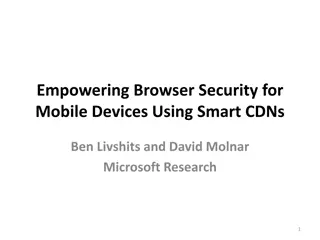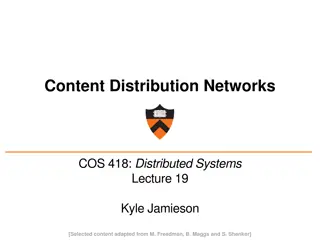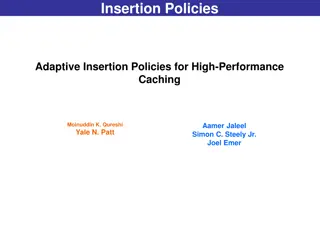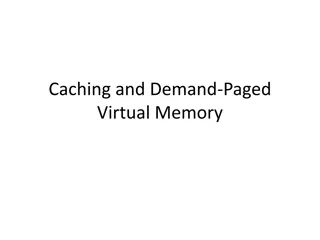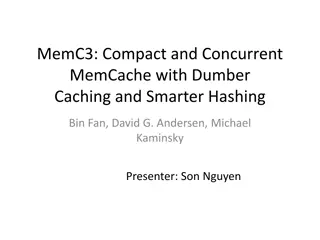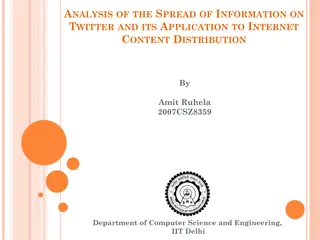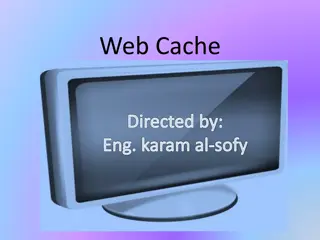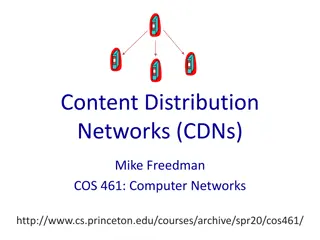Understanding Web Caching, Proxies, and CDNs in Web Architecture
This comprehensive guide delves into the concepts of web caching, proxies, and CDNs, explaining their importance in web architecture. It covers topics such as caching mechanisms, browser cache management, what can be cached, and controlling caches with HTTP headers. The provided images visually illustrate key points discussed throughout the content.
Download Presentation

Please find below an Image/Link to download the presentation.
The content on the website is provided AS IS for your information and personal use only. It may not be sold, licensed, or shared on other websites without obtaining consent from the author. Download presentation by click this link. If you encounter any issues during the download, it is possible that the publisher has removed the file from their server.
E N D
Presentation Transcript
Web Caching, Proxies and CDNs COMP3227 Web Architecture & Hypertext Technologies Dr Heather Packer hp3@ecs.soton.ac.uk
Caching Caching stores the result of an operation so that future operations return faster Computation is slow Computation will run multiple times When the output is the same for a particular input 3
Web Caching The temporary storage (caching) of frequently accessed data for rapid access Typically caches store static assets HTML pages Images Stylesheets, Javascript Caches can be located at various points in a network Reduces access time/latency for clients Reduces bandwidth usage across slower links Reduces load on a server 4
Browser Cache Browsers maintain a small cache Local Browser Origin Server Stored locally Cache for a single user or application Browser sets a caching policy, deciding what data to cache resource User specific content Browser Cache Expensive content 5
What can be Cached? Be careful caching: Cache friendly Logos and brand images Style sheets Javascript files, site and library Fonts Downloadable content Media files Data HTML pages Frequently modified Javascript and CSS Content requested with authentication cookies Never cache Sensitive data User-specific data that frequently changes 6
Caching using Conditional requests Last-Modified: Tue 17 Nov 2020 08:00:20 GMT GET Requests: If-Modified-Since: HTTP Status code: 304 Not Modified Etag: 0123456789ABCDEF GET Request: If-None-Match: HTTP Status code: 304 Not Modified 7
Controlling Caches with HTTP: Last-Modified Header GET Conditional GET GET / HTTP/1.1 GET / HTTP/1.1 Host: comp3220.ecs.soton.ac.uk Host: comp3220.ecs.soton.ac.uk Accept: */* Accept: */* If-Modified-Since: Tue 17 Nov 2023 08:00:20 GMT HTTP/1.1 200 OK Date: Wed 18 Nov 2023 17:43:20 GMT Connection: keep-alive HTTP/1.1 304 Not Modified Content-Type: text/html; charset=UTF-8 Date: Wed 15 Nov 2017 07:55:10 GMT Content-Length: 4003 Connection: keep-alive Last-Modified: Tue 17 Nov 2023 08:00:20 GMT Last-Modified: Tue 17 Nov 2023 08:00:20 GMT 8
Caching Headers HTTP Response header Cache-Control: Flags no-store no-cache max-age= must-revalidate public private Use of Cache-Control headers to be determined by website architect/designer 9
HTTP with Cache-Control Header GET GET GET / HTTP/1.1 * No request sent * Host: comp3220.ecs.soton.ac.uk Accept: */* HTTP/1.1 200 OK Date: Wed 18 Nov 2023 17:43:20 GMT Connection: keep-alive Content-Type: text/html; charset=UTF-8 Content-Length: 4003 Last-Modified: Tue 17 Nov 2023 08:00:20 GMT Cache-Control: max-age=86400 10
Different Web Caching Solutions Caches can be located at various points in a network Browser Cache Embedded in the browser Proxy Cache Reverse Proxy Cache 11
Proxy Cache Cache located close to the clients (hosted by University or Internet Service Provider) Server Decrease bandwidth usage Decreases network latency Local Machine Scale provides the main advantage: many users within the ISP may all be asking for the same web pages resource ISPs use this approach to decrease bandwidth across their networks Proxy Cache 12
Reverse Proxy Cache Cache proxy located closer to the origin web server Server Usually deployed by a Web host Decreases load on the Web service (e.g. database) Local Machine Reverse Proxy Cache Several reverse proxy caches implemented together can for a Content Delivery Network resource 13
Web Proxy Architecture A web proxy is a network service They receive web requests from clients and make requests on their behalf to web servers A web proxies behaviour differs depending on their function 15
No Proxy 16
Proxy Types P Forward Proxy P Open Proxy P Reverse Proxy 17
Forward Proxy Content Filtering P Restricts requests Blocks blacklisted URLs Response can be scanned Unwanted content Malware 18
Forward Proxy Content Translation P Transform responses Reduce bandwidth usage by client Commonly used by mobile phone networks Recompress images at lower resolution Minimising HTML, CSS and JavaScript Inject content into web pages e.g. adverts 19
Open Forward Proxy - Access Services Anonymously P Client accessing website via proxy: Masks their IP address Modifies their location (via GeoIP) Improve anonymity Defeat geo-blocking No filtering, encryption, or checks over content 20
Reverse Proxy Load-balancing P Distributes incoming web requests to a pool of web servers (targets) Performance and availability Many strategies including: round robin, weighted round robin Health checks ensure resilience 21
Reverse Proxy Content Switching static P html Examine incoming request and direct traffic to specific web servers Can use: Host or path based e.g. https://example.com/static -> static webserver IP address, cookie or user-agent api 22
Reverse Proxy Protocol Translation P HTTPS SSL/TLS off-loading (OSI Layer 6) Incoming web requests over https, internal communications via http HTTP/2 to HTTP/1.x (OSI Layer 7) IPv6 <-> IPv4 (OSI Layer 3) 23
Reverse Proxy Monitoring and filtering P Monitor incoming requests Access logs / statistics Filter incoming requests Check security credentials (eg valid API tokens) Rate limit requests Intrusion detection and handling DDoS attacks Applying security policies (WAF) 24
Motivation Scenario Stream video content to 100,000+ simultaneous users You could use a single large mega-server Single point of failure Point of network congestion Long path to distant clients Multiple copies of video sent over outgoing link This solution doesn t work in practice 26
Content Delivery Network User Connection CDN Connection Origin Server Edge Server User CDN a geographically distributed network of proxy servers (edge nodes) Hosts static content (such as images, videos, CSS and JS) Data travels to user via the shortest path (reduced latency) 27
A map of global fiber backbone networks and Internet exchange points 28
CDN Video streaming Software downloads Web and mobile content acceleration Payment services E-commerce News YouTube Services that use CDNs Hulu Netflix Wikipedia Amazon CNN Reddit New York Times Twitch The Guardian gov.uk Commerical CDNS Limelight Networks Level 3 Communications Akamai Technologies Amazon CloudCDN CloudFlare Stack Overflow PayPal GitHub Shopify Stripe BBC.com Quora Vimeo 29
Motivational Scenario Streaming video to 100,000+ simultaneous users Working Web solution: store/serve many copies of video at multiple geographically distributed sites (CDN) Two strategies: 1. Push CDN servers deep into many access networks Close to users Better latency and better network performance. Placed near ISP Harder to maintain because there are many more servers in the CDN. Used by Akamai, 1700 locations 2. Place larger clusters at key points in the network near internet exchanges Higher latency and lower performance for the end user Internet exchanges where network providers connect their networks to each other Dedicated high speed private networks are used to connect the clusters together Easier to manage but with higher latency and lower performance for the end user. Used by Limelight 30
CDN: Simple content access scenario A CDN has to be able to tell clients where to find resources A client will request a file, with one URL but retrieve it from another http://video.netcinema.com/6Y7B23V http://KingCDN.com/NetC6Y7B23V 31
1. Contacts www.netcinema.com and receives a link to a video http://video.netcinema.com/6Y7B23V 32
2. Resolves Domain name via local DNS video.netcinema.com 33
3. NetCinemas DNS returns cdn1.KingCDN.com 4. Resolves Domain name cdn1.KingCDN.com 5. Returns IP of cdn1.KingCDN.com 34
6. Requests URL http://cdn1.KingCDN.com/NetC6Y7B23V 35
CDN Cluster Selection Strategy The CDN s DNS decides which edge server to use Pick CDN node geographically closest to client Pick CDN node with shortest delay (min hops) to client (CDN nodes periodically ping access ISPs, report results to CDN DNS) Or let the Client decide give client a list of several CDN servers 36
Case Study: Netflixs First Approach Owned very little infrastructure, uses 3rd party services Own registration, payment servers Amazon (3rd party) cloud services Netflix uploads studio master to Amazon cloud Create multiple version of movie (different encodings) in cloud Upload versions from cloud to CDNs Three 3rd party CDNs host/stream Netflix content: Akamai, Limelight, Level-3 37
DASH - Dynamic Adaptive Streaming over HTTP Server Divides video files into multiple chucks Each chunk stored encoded at different bit rates Manifest file: provides URLs for different chunks Client Periodically measures server-to-client bandwidth Consulting manifest, requests one chunk at a time Chooses maximum coding rate sustainable given current bandwidth Can choose different coding rates at different points in time (depending on available bandwidth at time) The intelligence happens at the client level to make sure that there is no buffer starvation or overflow 39
MPEG-DASH Adoption MPEG DASH is independent, open and international standard, which has broad support from the industry HTML5 Media Source Extensions and HbbTV are MPEG-DASH enabled Heavy plugins like Silverlight and Flash perform poorly and cause security issues Chrome dropped Silverlight support in 2015 Firefox dropped Silverlight support in 2017 It was a problem for the majority of premium video providers Video providers delivered their streams via Smoothstreaming and Playready DRM, which enforced Silverlight These providers switch to using HTML5 with MPEG-DASH and MPEG-CENC based DRM Less than 0.02% of sites used Silverlight 2023 40
Netflix OpenConnect Netflix wanted the absolute best streaming they could get, while lowering cost High optimised for delivery large files, still use Akamai for small assets Data centers around the world There may be a data center with a couple of racks that contain the entire Netflix library Others might only have 80% of the most popular content Unpopular material will have to travel further Client Intelligence Calculates best edge server to use (based on bit rate and closeness) Selects which edge server based on the required bit rate and latency Continually probes the best way of receiving content 41












